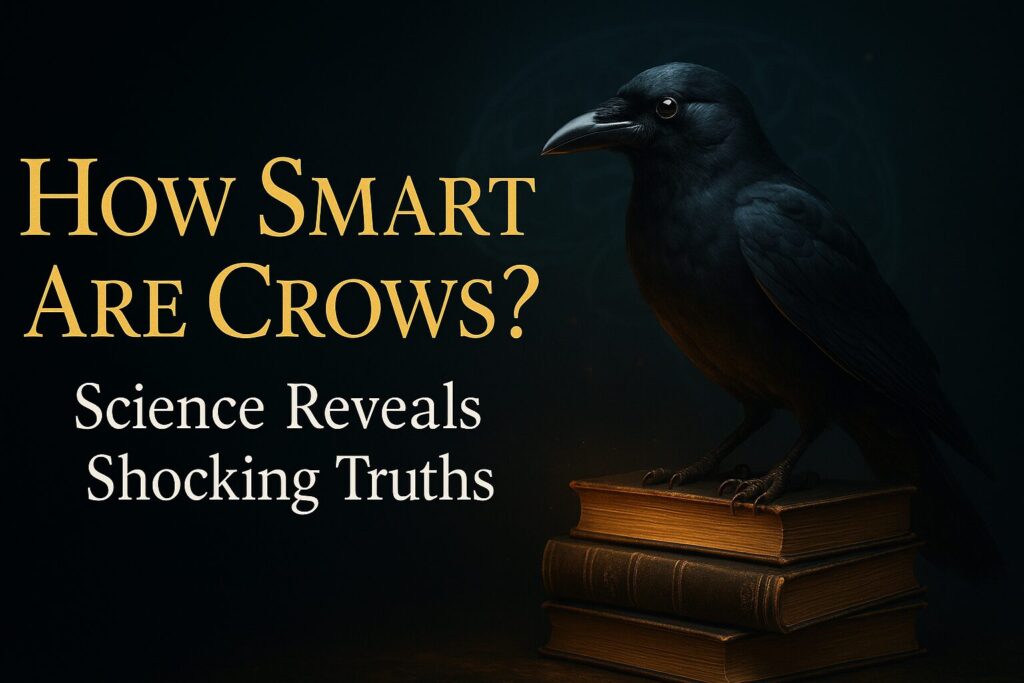Discover the shocking intelligence of the crow family tool use, face recognition, puzzles, and more. Science reveals how smart crows truly are.
Table of Contents
Introduction
Crows have long fascinated humans with their mysterious presence, eerie calls, and sharp eyes. But beyond their dark feathers and ominous reputation lies something far more astonishing intelligence that rivals some of the smartest animals on the planet. In fact, members of the crow family (scientifically known as Corvidae) exhibit remarkable cognitive skills that continue to surprise scientists.
These birds are not just surviving they’re thriving. From navigating busy cities to recognizing human faces, the crow family demonstrates advanced learning, memory, and problem-solving capabilities. With growing interest in animal cognition, crows have become the subject of numerous studies aiming to decode just how smart they truly are.
In this article, we explore the shocking truths behind crow intelligence rooted in real science, field experiments, and cultural insights. Whether you’re curious about their crow sound, crow history, or how they use tools like humans, prepare to see these birds in a new light.
Let’s begin by understanding what actually makes them so smart.
What Makes Crows So Smart?
The intelligence of crows isn’t just anecdotal it’s backed by neuroscience and evolutionary biology. Members of the crow family possess an unusually large brain relative to their body size. In fact, when compared proportionally, their brain-to-body ratio is similar to that of great apes.
Here’s what contributes to their impressive brainpower:
1. Advanced Brain Structure
- Unlike mammals, birds don’t have a neocortex. But crows make up for it with a densely packed forebrain called the nidopallium caudolaterale a region involved in decision-making and problem-solving.
- Research published in Science found that the neural density in the crow family rivals that of primates.
2. High Neuron Count
- A 2016 study from Vanderbilt University revealed that crows have more neurons in their forebrains than some monkey species.
- More neurons generally mean more processing power enabling crows to plan, reason, and even delay gratification.
3. Social Intelligence
- Crows live in complex social groups and are capable of social learning. Young crows often learn survival strategies by observing their elders.
- They also understand cooperation and engage in activities like food sharing and group defense behaviors that reflect a deep understanding of group dynamics.
4. Adaptability
- Whether in rural landscapes or bustling cities, the crow family adapts quickly. Their ability to assess new environments and modify behavior is a hallmark of high intelligence.
These traits, combined with an innate curiosity and long memory, make crows one of the most cognitively advanced bird species on Earth.
Scientific Studies That Prove Crow Intelligence
If there’s any doubt about the intelligence of the crow family, scientific research puts it to rest. Over the past two decades, crows have been studied in labs and the wild, revealing a cognitive skill set that rivals even primates.
Here are some of the most compelling studies:
1. The Aesop’s Fable Experiment
In this classic experiment, researchers presented crows with a tube partly filled with water and a floating treat out of reach. The only way to get the food was to drop objects into the tube to raise the water level just like the thirsty crow in Aesop’s fable.
- Not only did the crows use stones to increase the water level, but they also selected the most effective ones (e.g., heavier over lighter).
- This demonstrated causal reasoning a skill not commonly seen outside humans and apes.
2. Tool Use in New Caledonian Crows
New Caledonian crows are among the most famous tool users in the animal kingdom.
- In a series of lab studies, they bent wires into hooks to retrieve food an example of tool manufacturing, not just usage.
- According to research published in Current Biology, these crows also use tools sequentially using one tool to retrieve another showing planning and foresight.
3. Face Recognition Studies
University of Washington researchers wore masks while capturing and releasing crows. Years later, when the masked people returned, the crows remembered and scolded them sometimes even rallying other crows to join in.
- This confirmed long-term memory and social teaching; the crows that hadn’t seen the masked person learned to react by watching others.
4. Understanding Analogies
Crows have shown the ability to understand analogies, such as “A is to B as C is to D” a type of relational thinking considered a cornerstone of human intelligence.
Together, these studies confirm that the crow family isn’t just smart they’re capable of abstract thinking, problem-solving, and even cultural learning.
Do Crows Really Use Tools?
Yes absolutely. Among all bird species, the crow family stands out as one of the few known to not only use tools but also design and modify them based on the task at hand. This places crows in an elite group of animals that includes chimpanzees and humans.
Real-World Examples of Crow Tool Use
- New Caledonian crows, often studied for their intelligence, are famous for using twigs, leaves, and even their own feathers to extract insects from tree bark or hard-to-reach places.
- In captivity, these crows have shown they can bend wires into hooks to lift food from containers without prior training.
- Some even create multi-step tool chains, like using one stick to retrieve another longer stick before accessing the final food reward.
Tool Innovation and Memory
- Tool use in the crow family isn’t random it’s thoughtful and calculated.
- Crows remember which tool worked best for which problem and can return to those tools later.
- According to Science Advances, New Caledonian crows pass on tool-making techniques to younger generations, indicating cultural transmission an extremely rare trait in animals.
A Cognitive Leap
What makes crow tool use so impressive isn’t just the act itself but the mental model behind it. Tool use requires:
- Planning ahead
- Understanding cause and effect
- Adapting based on trial and error
- Storing and retrieving specific knowledge
This kind of behavior is not common in the animal kingdom and underscores just how cognitively evolved the crow family truly is.
Can Crows Solve Puzzles? Insights from Lab Tests
One of the most stunning displays of intelligence in the crow family comes from their ability to solve complex puzzles some of which rival the difficulty level faced by young children or monkeys. Lab tests have revealed how flexible, patient, and strategic these birds can be.
Multi-Step Problem Solving
In controlled settings, crows have been presented with multi-step tasks requiring:
- Selecting the correct tool from a set
- Using one tool to retrieve another
- Unlocking latches in sequence to access food
One famous study by Dr. Alex Taylor at the University of Auckland tested a New Caledonian crow named 007. The bird had to perform eight sequential steps to solve a puzzle box and succeeded on the first try after observing the setup. This required not only memory but also pre-planning and reasoning, which are rare in non-human animals.
Understanding Cause and Effect
In other tests, crows have:
- Identified which containers held food based on subtle sound cues (like shaking)
- Chosen correct shapes to fit into matching holes, much like toddlers playing with shape sorters
- Ignored decoy objects that previously failed, showing learning from experience
Delayed Gratification and Focus
Studies have also tested crows for impulse control, similar to the famous “marshmallow test” used on children. Crows have demonstrated the ability to wait longer for a better reward something even many mammals struggle with.
These lab experiments prove that the crow family doesn’t just act on instinct. They can strategize, adapt in real-time, and apply knowledge from previous experiences all hallmarks of high-level intelligence.
Do Crows Recognize Human Faces?
Yes, crows not only recognize individual human faces, but they also remember them for years and can even pass that knowledge to other crows. This remarkable skill shows how the crow family navigates social and survival challenges using long-term memory and observational learning.
Landmark Study: The Masked Human Experiment
In a now-famous study from the University of Washington, researchers wore two types of masks:
- One mask was worn while trapping and tagging crows (a negative experience).
- The other was used during neutral interactions.
Years later, crows that had seen the “dangerous” face would mob the masked person cawing loudly and even recruiting other crows to harass them. Astonishingly, this response spread generationally:
- Young crows who had never seen the trapping themselves reacted aggressively after watching older crows.
- This proved social learning and long-term facial recognition.
Real-Life Applications
People who feed or interact with crows regularly often report:
- Being followed or greeted by familiar crows
- Receiving shiny “gifts” (like coins, buttons, or beads) in return
- Having crows warn them of nearby predators
This behavior supports the idea that the crow family not only distinguishes between individual humans but forms long-term associations positive or negative based on experience.
Why This Matters
Recognizing and remembering faces is a complex cognitive task. It requires:
- Visual processing
- Emotional memory
- The ability to associate people with events
Very few animals can do this. The fact that crows can without formal training underscores just how socially intelligent and perceptive the crow family really is.
Can Crows Communicate With Each Other?
Absolutely. Communication within the crow family is not only complex but also purposeful, emotional, and often strategic. Crows use a combination of sounds, body language, and behavior to share information and possibly even emotions.
Vocal Language: Decoding the “Crow Sound”
Crows are known for their distinctive caw, but their vocal range goes far beyond that:
- Researchers have documented over 250 unique crow sounds, varying in pitch, tone, and intensity.
- These sounds serve different purposes warnings, greetings, mating calls, and territory claims.
- Some crow calls are specific to individual family members, acting almost like names.
In Japan, urban crows have developed distinct vocal dialects, proving that crow communication can evolve regionally, much like human language.
Alarm Systems and Tactical Warnings
When a crow spots danger (such as a predator or a threatening human), it lets out a sharp, repeated call to alert nearby crows. The response is often immediate:
- Other crows gather, observe, and respond together sometimes mobbing the threat.
- These warning calls differ depending on the type of danger, showing an ability to encode specific information.
Nonverbal Communication
Beyond sound, crows use:
- Wing and tail flicks
- Body posture changes
- Cooperative signals like flying in circles or guiding others to food sources
This multi-modal communication mirrors that seen in social mammals like elephants and dolphins.
Social Learning Through Communication
Young crows learn not only how to call but when to call based on the reactions of their parents and peers. This is a clear example of vocal learning, which is extremely rare in birds outside of parrots and songbirds.
In short, the crow family communicates with intelligence, purpose, and social sensitivity proving their vocalizations are far more than just noise.
Are Crows as Smart as Primates?
It might sound surprising, but many scientists now believe that crows rival primates in several key aspects of intelligence. While they differ in brain structure, the cognitive abilities of the crow family match and in some cases exceed those seen in apes and monkeys.
Brainpower on Par with Monkeys
- Crows have a high neuron density, especially in the pallium (their version of the cerebral cortex).
- A 2016 study published in PNAS (Proceedings of the National Academy of Sciences) revealed that crows have more neurons in their forebrains than many primate species allowing for faster, more efficient processing.
This gives crows the mental resources to:
- Plan ahead
- Solve abstract puzzles
- Use tools creatively
- Recognize themselves in mirrors (a rare form of self-awareness)
Similarities in Cognitive Abilities
Let’s compare some specific traits:
| Trait | Primates | Crows (Crow Family) |
|---|---|---|
| Tool usage | Yes | Yes |
| Facial recognition | Yes | Yes |
| Problem-solving | Yes | Yes |
| Social learning | Yes | Yes |
| Future planning | Yes | Yes |
| Empathy or bonding behavior | Yes | Observed |
This overlap shows that intelligence doesn’t always require a mammalian brain it can emerge through convergent evolution, where different species evolve similar traits due to similar survival challenges.
Intelligence Without a Cortex
Primates have a layered neocortex long thought essential for higher thinking. Birds like crows lack this, yet show comparable reasoning skills. Their differently-structured brains offer new insights into how intelligence works across species.
In short, while they don’t have opposable thumbs or swing from trees, the crow family rivals many primates in memory, logic, adaptability, and social intelligence.
How Crows Adapt to Urban Life
One of the most fascinating aspects of the crow family is their remarkable adaptability especially in urban environments. While many bird species struggle in cities, crows not only survive they thrive.
Masters of the Concrete Jungle
Cities offer unique challenges: noise pollution, traffic, scarcity of natural food sources, and constant human activity. Yet crows have turned these into advantages.
- Traffic timing: In Japan, crows have been observed dropping nuts on crosswalks, waiting for cars to crack them open, and then retrieving the food safely when the light turns red.
- Trash scavenging: Urban crows open trash bags, flip bin lids, and even memorize garbage collection schedules to find meals.
- Tool usage in cities: Some urban crows use sticks to retrieve food from vending machine slots or narrow gaps.
These behaviors require keen observation, memory, and flexible problem-solving hallmarks of intelligence.
Navigating Human Culture
Crows also recognize human behaviors and patterns:
- They learn which parks or rooftops offer the most reliable food sources.
- They distinguish between threatening and non-threatening humans, often avoiding areas where they’ve been harassed.
- They remember locations of feeding, danger, and shelter and share this information with their group.
Changes in Communication
Studies show that urban crows modify their crow sound to be louder or higher-pitched to cut through background city noise an adaptation also seen in human-dominated soundscapes.
Urban Crow Lifespan and Health
Despite pollution and human risks, urban crows tend to have a longer lifespan than rural ones. Why? Cities provide:
- Steady food supplies
- Fewer natural predators
- Warmer microclimates during winter
This adaptability proves that the crow family is not just intelligent, but highly responsive to changing environments further solidifying their status as cognitive marvels.
Cultural and Historical Beliefs About Crow Intelligence
Throughout history, the crow family has occupied a powerful place in human myth, folklore, and symbolism. Across many cultures and eras, crows have been seen not just as birds but as messengers, tricksters, or even omens. Much of this symbolism stems from the crow’s intelligence, mysterious nature, and haunting crow sound.
Ancient Beliefs and Mythology
- Native American cultures often saw crows as clever tricksters or sacred beings. In some tribes, the crow was a creator figure, responsible for shaping the world.
- In Celtic and Norse mythology, crows were associated with war, fate, and prophecy. Odin, the Norse god, was accompanied by two crows Huginn and Muninn representing thought and memory.
- In Hinduism, crows are linked to ancestors and spiritual messages. Feeding crows during certain rituals is believed to bring blessings and show respect to one’s lineage.
In Literature and Folklore
- Aesop’s fables portrayed crows as resourceful problem-solvers long before modern science confirmed their skills.
- In Shakespeare’s time, crows were symbols of wisdom or mystery, depending on the context.
- Many old folktales across Europe described crows as birds who could predict storms, detect lies, or guard secrets.
Modern Superstitions and Symbolism
While some cultures view crows as bad omens, others see them as protectors or guardians of hidden knowledge:
- In parts of Asia, hearing a crow sound near a home may signal a guest or message.
- In popular culture, crows often appear in stories involving magic, transformation, or intelligence like Edgar Allan Poe’s The Raven.
These cultural perspectives reflect humanity’s long-standing fascination with the crow family recognizing, long before science did, that there’s more to these birds than meets the eye.
Final Thoughts: What Can We Learn From Crows?
Crows are not just birds with black feathers and eerie calls they are thinking, learning, and remembering creatures. The more we study the crow family, the more we discover how deeply intelligent, socially aware, and emotionally complex they are.
They’ve shown us that:
- Intelligence isn’t limited to mammals or large-brained animals.
- Tool-making, long-term memory, and communication can evolve independently in different species.
- Adaptability, curiosity, and collaboration are powerful survival tools in both natural and urban environments.
The crow family teaches us that brains can take many forms and that understanding animal minds requires us to rethink our traditional definitions of intelligence. From bending wires into hooks to recognizing human faces, from passing knowledge to future generations to adjusting their crow sound for city life, crows continue to challenge and inspire scientists and bird lovers alike.
Perhaps the most humbling lesson from crows is this: we are not as intellectually unique as we once believed. Intelligence exists all around us soaring silently in the sky, cawing from rooftops, and watching us with sharp eyes and sharper minds.





